Sustainability in Mountain Viticulture: Insights from a Case Study in the Portuguese Douro Region
Abstract
1. Introduction
2. Materials and Methods
2.1. Study Area
2.2. Data Collection
2.3. Environmental and Economic Balances
2.3.1. Environmental Assessment
Human Labor and Its Potential Environmental Impact
2.3.2. Economic Assessment
3. Results
3.1. Economic Assessment
3.2. Environmental Assessment
3.2.1. Evaluation Methods and Indicators
3.2.2. Human Labor and CO2-Eq
3.3. General Overview Assessment
4. Discussion
4.1. Economic Assessment
4.2. Environmental Assessment
4.3. Human Labor
4.4. Functional Units
5. Conclusions
Supplementary Materials
Author Contributions
Funding
Informed Consent Statement
Data Availability Statement
Acknowledgments
Conflicts of Interest
References
- Nistor, E.; Dobrei, A.G.; Dobrei, A.; Carmen, D.; Sala, F.; Prundeanu, H. N2O, CO2, Production, and C Sequestration in vineyards: A review. Water Air Soil Pollut. 2018, 229, 299. [Google Scholar] [CrossRef]
- Ponstein, H.; Meyer-Audrich, A.; Prochnow, A. Greenhouse gas emissions and mitigation options for German wine production. J. Clean. Prod. 2018, 212, 800–809. [Google Scholar] [CrossRef]
- Maesano, G.; Milani, M.; Nicolosi, E.; D’Amico, M.; Chinnici, G. A network analysis for environmental assessment in wine supply chain. Agronomy 2022, 12, 211. [Google Scholar] [CrossRef]
- Renaud-Gentié, C.; Dieu, V.; Thiollet-Scholtus, M.; Mérot, A. Addressing organic viticulture environmental burdens by better understanding interannual impact variations. Int. J. Life Cycle Assess. 2020, 25, 1307–1322. [Google Scholar] [CrossRef]
- Chiriacò, M.V.; Belli, C.; Tommaso, C.; Trotta, C.; Sabbatini, S. The potential carbon neutrality of sustainability viticulture showed through a comprehensive assessment of the greenhouse gas (GHG) budget of wine production. J. Clean. Prod. 2019, 225, 435–450. [Google Scholar] [CrossRef]
- Ferrara, C.; De Feo, G. Life Cycle Assessment application to the wine sector: A critical review. Sustainability 2018, 10, 395. [Google Scholar] [CrossRef]
- Rouault, A.; Beauchet, S.; Renaud-Gentie, C.; Jourjon, F. Life Cycle Assessment of viticultural technical management routes (TMRs): Comparison between an organic and an integrated management route. J. Int. Sci. Vigne Vin 2016, 50, 77–89. [Google Scholar] [CrossRef]
- Meneses, M.; Torres, C.M.; Castells, F. Sensitivity analysis in a life cycle assessment of an aged red wine production from Catalonia, Spain. Sci. Total Environ. 2016, 562, 571–579. [Google Scholar] [CrossRef]
- Letamendi, J.; Sevigne-Itoiz, E.; Mwabonje, O. Environmental impact analysis of a Chilean organic wine through a life cycle assessment. J. Clean. Prod. 2022, 371, 133368. [Google Scholar] [CrossRef]
- Venkat, K. Comparison of twelve organic and conventional farming systems: A Life Cycle greenhouse gas emissions perspective. J. Sustain. Agric. 2012, 36, 620–649. [Google Scholar] [CrossRef]
- Villanueva-Rey, P.; Vásquez-Rowe, I.; Moreira, M.; Feijoo, G. Comparative life cycle assessment in the wine sector: Biodynamic vs. conventional viticulture activities in NW Spain. J. Clean. Prod. 2014, 65, 330–341. [Google Scholar] [CrossRef]
- Neto, B.; Dias, A.; Machado, M. Life cycle assessment of the supply chain of a Portuguese wine: From viticulture to distribution. J. Life Cycle Assess. 2013, 18, 590–602. [Google Scholar] [CrossRef]
- Martins, A.; Araújo, A.; Morgado, A.; Graça, A.; Caetano, N.; Mata, T. Towards sustainability wine: Comparison of two Portuguese wines. J. Clean. Prod. 2018, 183, 662–676. [Google Scholar] [CrossRef]
- Valero, A.E.; Howarter, J.A.; Sutherland, J.W. Sustainable Wine Scoring System (SWSS): A life cycle assessment (LCA) multivariable approach. BIO Web Conf. 2019, 12, 03016. [Google Scholar] [CrossRef]
- Meier, M.S.; Stoessel, F.; Junbluth, N.; Juraske, R.; Schader, C.; Stolze, M. Environmental impacts of organic and conventional agricultural products—Are the differences captured by life cycle assessment? J. Environ. Manag. 2015, 149, 193–208. [Google Scholar] [CrossRef]
- Marras, S.; Masia, S.; Duce, P.; Spano, D.; Sirca, C. Carbon footprint on a mature vineyard. Agric. For. Meteorol. 2015, 214–215, 350–356. [Google Scholar] [CrossRef]
- Rugani, B.; Vázquez-Rowe, I.; Benedetto, G.; Benetto, E. A comprehensive review of carbon footprint analysis as an extended environmental indicator in the wine sector. J. Clean. Prod. 2013, 54, 61–77. [Google Scholar] [CrossRef]
- Navarro, A.; Puig, R.; Kiliç, E.; Penavayre, S. Eco-innovation and benchmarking of carbon footprint data for vineyards and wineries in Spain and France. J. Clean. Prod. 2016, 142, 1661–1671. [Google Scholar] [CrossRef]
- Jradi, S.; Chameeva, T.; Delhomme, B.; Jaegler, A. Traking carbon footprint in French vineyards: A DEA performance assessment. J. Clean. Prod. 2018, 192, 43–54. [Google Scholar] [CrossRef]
- Trombly, A.J.; Fortier, M.-O.P. Carbon footprint of wines from finger lakes region in New York State. Sustainability 2019, 11, 2945. [Google Scholar] [CrossRef]
- Navarro, A.; Puig, R.; Fullana-i-Palmer, P. Product vs corporate carbon footprint: Some methodological issues. A case study and review on the wine sector. Sci. Total Environ. 2017, 581–582, 722–733. [Google Scholar] [CrossRef]
- Silva, L.P.; Silva, J.C.G.E. Evaluation of the carbon footprint of the life cycle of the wine production: A review. J. Clean. Circ. Bioeconomy 2022, 2, 100021. [Google Scholar] [CrossRef]
- Vásquez-Rowe, I.; Rugani, B.; Benetto, E. Tapping carbon footprint variations in the European wine sector. J. Clean. Prod. 2013, 43, 146–155. [Google Scholar] [CrossRef]
- Niccolucci, V.; Galli, A.; Kitzes, J.; Pulselli, R.; Borsa, S.; Marchettini, N. Ecological Footprint analysis applied to the production of two Italian wines. Agric. Ecosyst. Environ. 2008, 128, 162–166. [Google Scholar] [CrossRef]
- Litskas, V.; Mandoulaki, A.; Vogiatzakis, I.N.; Tzortzakis, N.; Stavrinides, M. Sustainable viticulture: First determination of the environmental footprint of grapes. Sustainability 2020, 12, 8812. [Google Scholar] [CrossRef]
- Wang, Y.; Li, Y.; Sun, T.; Milne, E.; Yanj, Y.; Liu, K.; Li, J.; Yan, P.; Zhao, C.; Li, S.; et al. Environmental impact of organic and conventional wine grape production, a case study from Wuwei wine region, Gansu Province, China. Ecol. Indic. 2023, 154, 110730. [Google Scholar] [CrossRef]
- Laca, A.; Gancedo, S.; Laca, A.; Diaz, M. Assessment of the environmental impacts associated with vineyards and winemaking. A case study in mountain areas. J. Environ. Sci. Pollut. Res. 2021, 28, 1204–1223. [Google Scholar] [CrossRef]
- Martins, A.; Araújo, A.; Morgado, A.; Graça, A.; Caetano, N.; Mata, T. Sustainability evaluation of a Portuguese “Terroir” wine. Chem. Eng. Trans. 2017, 57, 1945–1950. [Google Scholar] [CrossRef]
- Borsato, E.; Zucchinelli, M.; D’Ammaro, D.; Giubilato, E.; Zabeo, A.; Criscione, P.; Pizzol, L.; Cohen, Y.; Tarolli, P.; Lamastra, L.; et al. Use of multiple indicators to compare sustainability performance of organic vs conventional vineyard management. Sci. Total Environ. 2019, 711, 135081. [Google Scholar] [CrossRef]
- Weidema, B.P.; Thane, M.; Christensen, P.; Schmidt, J.; Løkke, S. Carbon footprint: A catalyst for life cycle assessment? J. Ind. Ecol. 2008, 12, 3–6. [Google Scholar] [CrossRef]
- Wright, L.; Kemp, S.; Williams, I. ‘Carbon footprint’: Towards a universally accepted definition. Carbon Manag. 2014, 2, 61–72. [Google Scholar] [CrossRef]
- Frischknecht, R.; Jungbluth, N.; Althaus, H.-J.; Doka, G.; Dones, R.; Heck, T.; Hellweg, S.; Hischier, R.; Nemeek, T.; Rebitzer, G.; et al. The Ecoinvent database: Overview and methodological framework. Int. J. Life Cycle Assess. 2004, 10, 3–9. [Google Scholar] [CrossRef]
- D’Ammaro, D.; Capri, E.; Valentino, F.; Grillo, S.; Fiorini, E.; Lamastra, L. Benchmarking of carbon footprint data from the Italian wine sector: A comprehensive and extended analysis. J. Sci. Total Environ. 2021, 779, 146416. [Google Scholar] [CrossRef]
- Gilinsky, A., Jr.; Newton, S.; Vega, F. Sustainability in the global wine industry: Concepts and cases. Agric. Agric. Sci. Procedia 2016, 8, 37–49. [Google Scholar] [CrossRef]
- Triviño-Tarradas, P.; Carranza-Cañadas, P.; Mesas-Carrascosa, F.-J.; Gonzalez-Sanchez, E.J. Evaluation of agricultural sustainability on a mixed vineyard and olive-grove farm in Southern Spain through the INSPIA model. Sustainability 2020, 12, 1090. [Google Scholar] [CrossRef]
- Vásquez-Rowe, I.; Villanueva-Rey, P.; Iribarren, D.; Moreira, M.T.; Feijoo, G. Join life cycle assessment and data envelopment analysis of grape production for vinification in the Rias Baixas appellation (NW Spain). J. Clean. Prod. 2012, 27, 92–102. [Google Scholar] [CrossRef]
- Falcone, G.; De Luca, A.I.; Stillitano, T.; Strano, A.; Romeo, G.; Gulisano, G. Assessment of environmental and economic impacts of vine-growing combining life cycle assessment, life cycle costing and multicriterial analysis. Sustainability 2016, 8, 793. [Google Scholar] [CrossRef]
- Martins, J.; Marta-Costa, A.; Lucas, M.R.; Santos, M. Economic and Environmental balance in viticulture: A case study in Douro. In Proceedings of the VII Internacional Congress, Mountain and Steep Sloves Viticulture, University of Trás-os-Montes e Alto Douro, Vila Real, Portugal, 12–14 May 2022. [Google Scholar]
- Zhang, C.; Rosentrater, K.A. Estimating economic and environmental impacts of red-wine-making process in the USA. J. Ferment. 2019, 5, 77. [Google Scholar] [CrossRef]
- Massuça, J.; Marta-Costa, A.; Lucas, M.R. Social dimension of sustainability: Assessment in the agribusiness context. New Medit 2023, 22, 63–80. [Google Scholar] [CrossRef]
- Elkington, J. Towards the sustainable corporation: Win-win-win business strategies for sustainable development. Calif. Manag. Rev. 1994, 36, 90–100. [Google Scholar] [CrossRef]
- Marta-Costa, A.; Trigo, A.; Costa, J.M.; Fragoso, R. Standards and indicators to assess sustainability: The relevance of metrics and inventories. In Improving Sustainable Viticulture and Winemaking Practices; Costa, J.M., Catarino, S., Escalona, J.M., Comuzzo, P., Eds.; Elsevier Editions; Elsevier Academic Press: London, UK, 2022; Chapter 20; pp. 391–414. [Google Scholar] [CrossRef]
- Merli, R.; Preziosi, M.; Acampora, A. Sustainability experiences in the wine sector: Towards the development of an international indicators system. J. Clean. Prod. 2018, 172, 3791–3805. [Google Scholar] [CrossRef]
- Santiago-Brown, I.; Metcalfe, A.; Jerran, C.; Collins, C. Sustainability assessment in wine-grape growing in the New World: Economic, environmental, and social indicators for agricultural businesses. Sustainability 2015, 7, 8178–8204. [Google Scholar] [CrossRef]
- IPMA—Instituto Português do Mar e da Atmosfera. Long Data Series. Available online: https://www.ipma.pt (accessed on 10 October 2023).
- ADVID—Cluster da Vinha e do Vinho e CoLAB VINES&WINES. ADVID Clim. Available online: https://www.advid.pt/ (accessed on 10 October 2023).
- DGADR—Direção Geral Agricultura e Desenvolvimento Rural. Produção Integrada. Available online: https://www.dgadr.gov.pt/images/docs/prod_sust/normas_pi/EBook_NormasPI/Prodi-Normas_envio-por-email_.pdf (accessed on 10 October 2023).
- Nemecek, T.; Bengoa, X.; Lansche, J.; Mouron, P.; Rossi, V.; Humbert, S. Methodological Guidelines for the Life Cycle Inventory Products, Version 2.0; World Food LCA database (WFLDB); Quantis: Lausanne, Switzerland; Agroscope: Zurich, Switzerland, 2014. [Google Scholar]
- IVDP—Instituto dos Vinhos do Douro e do Porto. Vine Culture. Available online: https://www.ivdp.pt/en/viticulture/vine-culture/ (accessed on 10 October 2023).
- Magalhães, N. Tratado de Viticultura—A Videira, A Vinha e o Terroir; Esfera Poética: Lisboa, Portugal, 2015. [Google Scholar]
- D’Aygalliers, P. Los Arboles Frutales y La Viña; Ed. Facsímil: Madrid, Spain, 2007. [Google Scholar]
- Reynier, A. Manual e Viticultura, 3rd ed.; Publicações Europa-América: Mem Martins, Portugal, 2004. [Google Scholar]
- Brickell, C. The Pruning, 5th ed.; Publicações Europa-América: Mem Martins, Portugal, 2000. [Google Scholar]
- Bretaudeau, J. Pruning and Grafting Fruit Trees; Litexa Editora: Lisbon, Portugal, 1985. [Google Scholar]
- Nemecek, T.; Schnetzer, J. Methods of Assessment of Direct Field Emissions for LCIs of Agricultural Production Systems, Data V3.0.(2012). Agroscope Reckenholz-Tänikon Research Station ART, Swiss Center for Life Cycle Inventories, Zurich and Dübendorf, CH, 2011. Available online: www.ecoinvent.ch (accessed on 6 October 2022).
- Silva, D.; Nunes, A.; Piekarski, C.; Morris, V.; Souza, L.; Rodrigues, T. Why using different Life Cycle Assessment software tools can generate different results for the same product system? A cause-effect analysis of the problem. Sustain. Prod. Consum. 2019, 20, 304–315. [Google Scholar] [CrossRef]
- IPCC. 2006 IPCC Guidelines for National Greenhouse Gas Inventories; Volume 4 Agriculture, forestry, and other land use; IGES: Kangawa, Japan, 2006. [Google Scholar]
- Matias, J.; Cerveira, A.; Santos, C.; Marta-Costa, A.A. Influência do preço da mão-de-obra na sustentabilidade das explorações vitícolas durienses: Uma aplicação de modelos baseados em agentes. Rev. De Econ. E Sociol. Rural. 2021, 59, e238886. [Google Scholar] [CrossRef]
- Rugani, B.; Panasiuk, D.; Benetto, E. An input-output based framework to evaluate human labour in life cycle assessment. Int. J. Life Cycle Assess. 2012, 17, 795–812. [Google Scholar] [CrossRef]
- INE—Instituto Nacional de Estatística. Statistics/Prices. Available online: https://www.ine.pt/xportal/xmain?xpgid=ine_tema&xpid=INE&tema_cod=1314 (accessed on 10 October 2023).
- IFAP—Instituto de Financiamento Agricultura e Pescas. Pedido Único. Available online: https://www.ifap.pt/web/guest/pedido-unico-enquadramento (accessed on 10 October 2023).
- IVV. Anuário 2022 de Vinhos e Aguardentes de Portugal; Instituto da Vinha e do Vinho: Lisboa, Portugal, 2023. [Google Scholar]
- Velten, S.; Leventon, J.; Jager, N.; Newig, J. What Is Sustainable Agricultural? A Systematic Review. Sustainability 2015, 7, 7833–7865. [Google Scholar] [CrossRef]
- Ponstein, H.; Chinoi, S.; Steiner, B. How to increase sustainability in the Finnish wine supply chain? Insights from a country of origin-based greenhouse gas emissions analysis. J. Clean. Prod. 2019, 226, 768–780. [Google Scholar] [CrossRef]
- Beauchet, S.; Rouaut, A.; Thiollet-Scholtus, M.; Renouf, M.; Jourjon, F.; Renaud-Gentié, C. Inter-annual variability in the environmental performance of viticulture technical management routes—A case study in the Midle Loire valley (France). Int. J. Life Cycle Assess. 2018, 24, 253–265. [Google Scholar] [CrossRef]
- UNESCO—United Nations Educational, Scientific and Cultural Organization. World Heritage List. Available online: https://whc.unesco.org/en/list/ (accessed on 12 October 2023).
- Recchia, L.; Sarri, D.; Rimediotti, M.; Boncinelli, P.; Cini, E.; Vieri, M. Towards the environmental sustainability assessment for the viticulture. J. Agric. Eng. 2018, 49, 586. [Google Scholar] [CrossRef]
- Gierling, F.; Blanke, M. Carbon reduction strategies for regionally produced and consumer wine: From farm to fork. J. Environ. Manag. 2021, 278, 111453. [Google Scholar] [CrossRef]
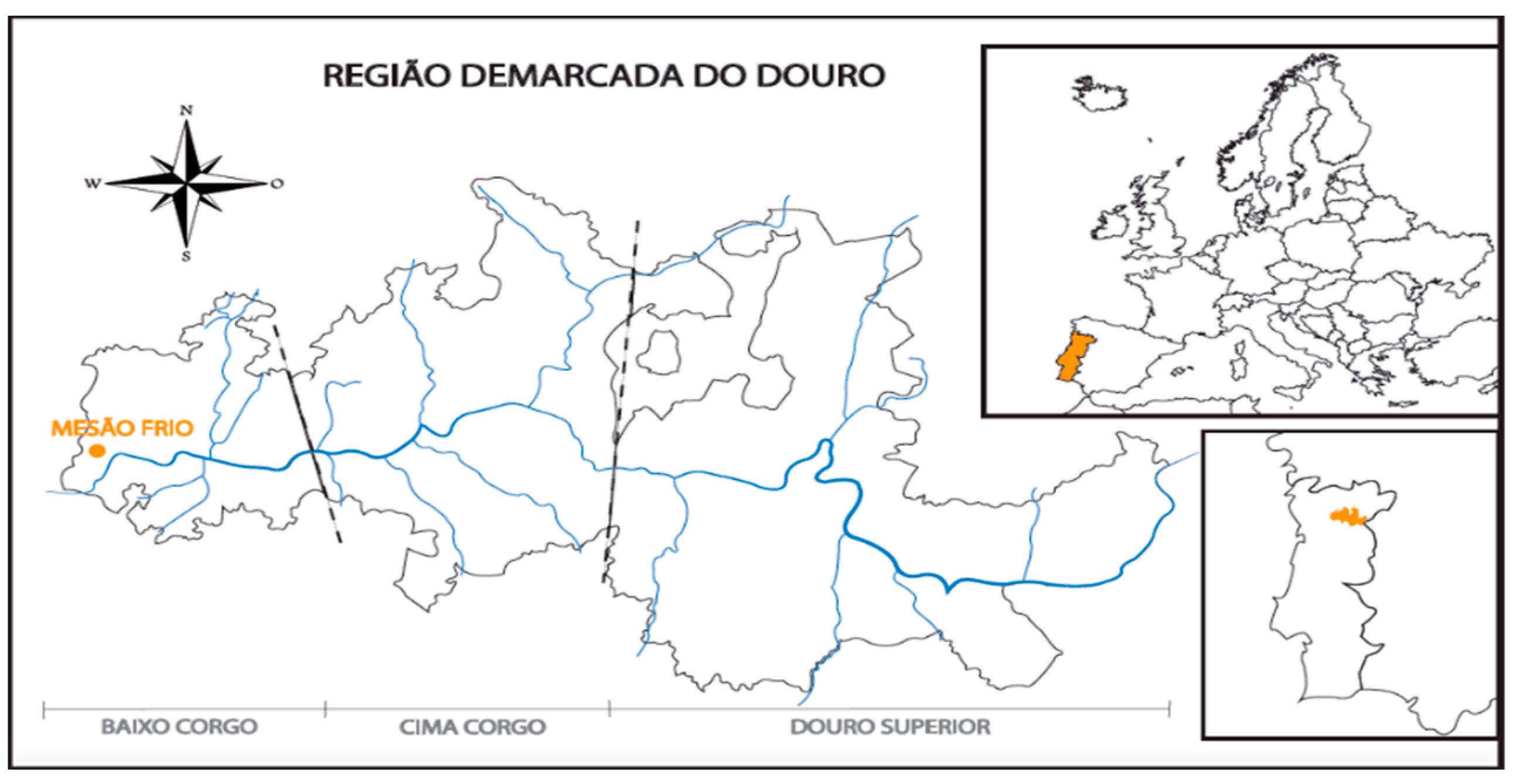

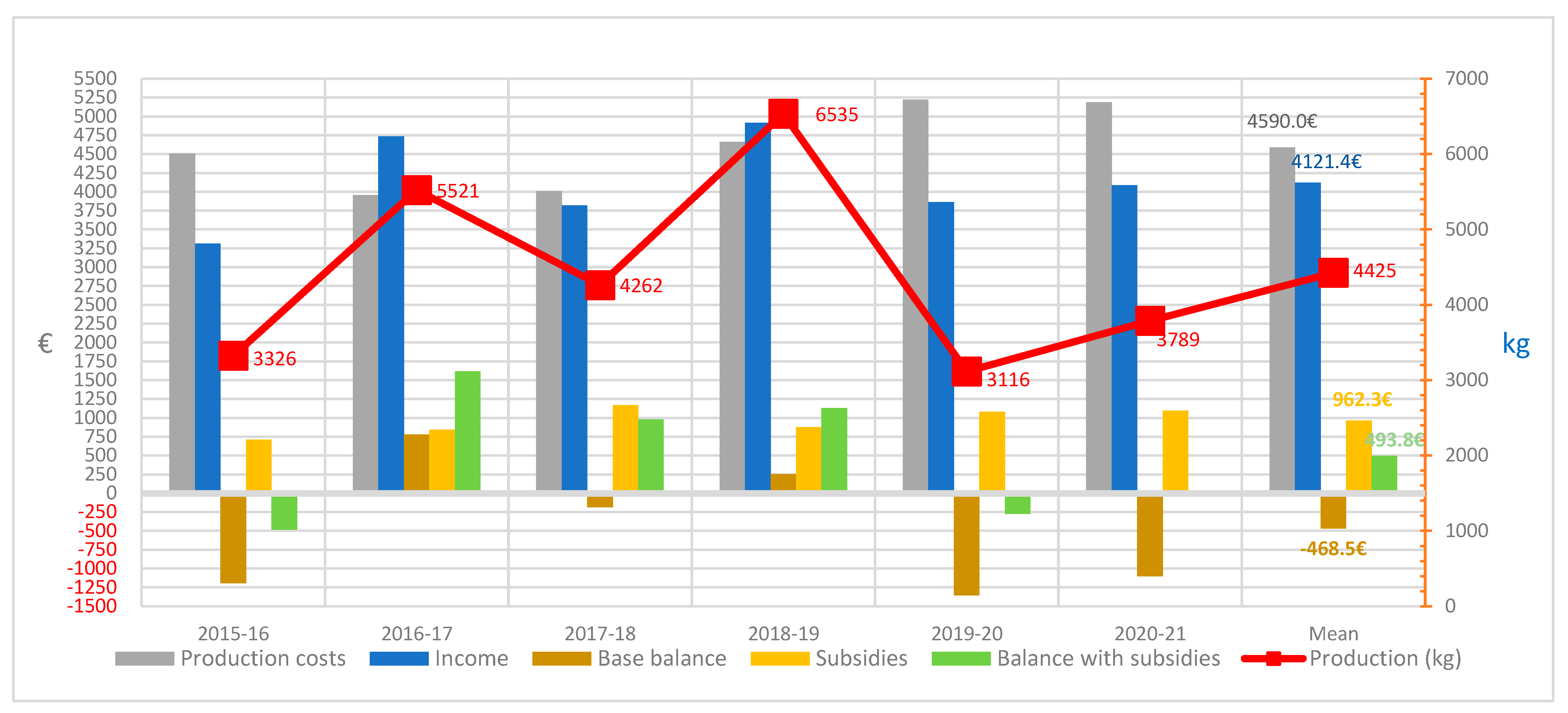
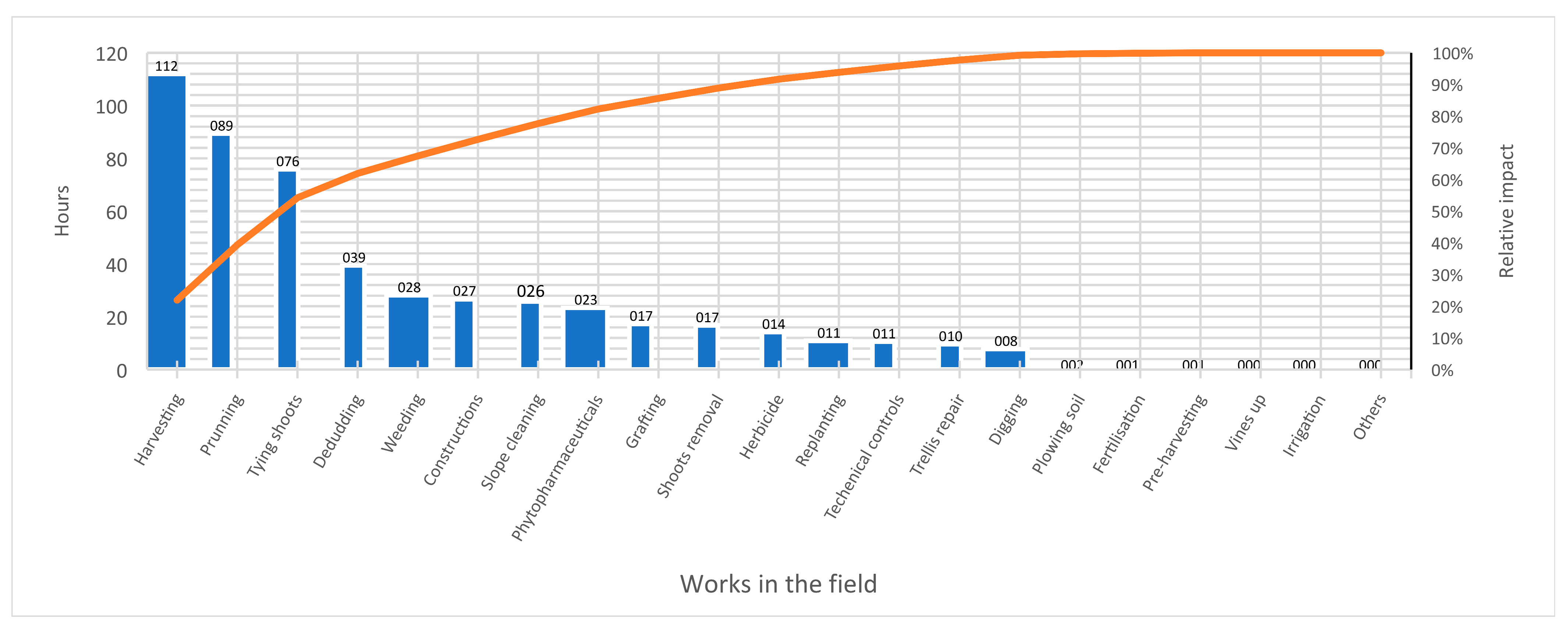

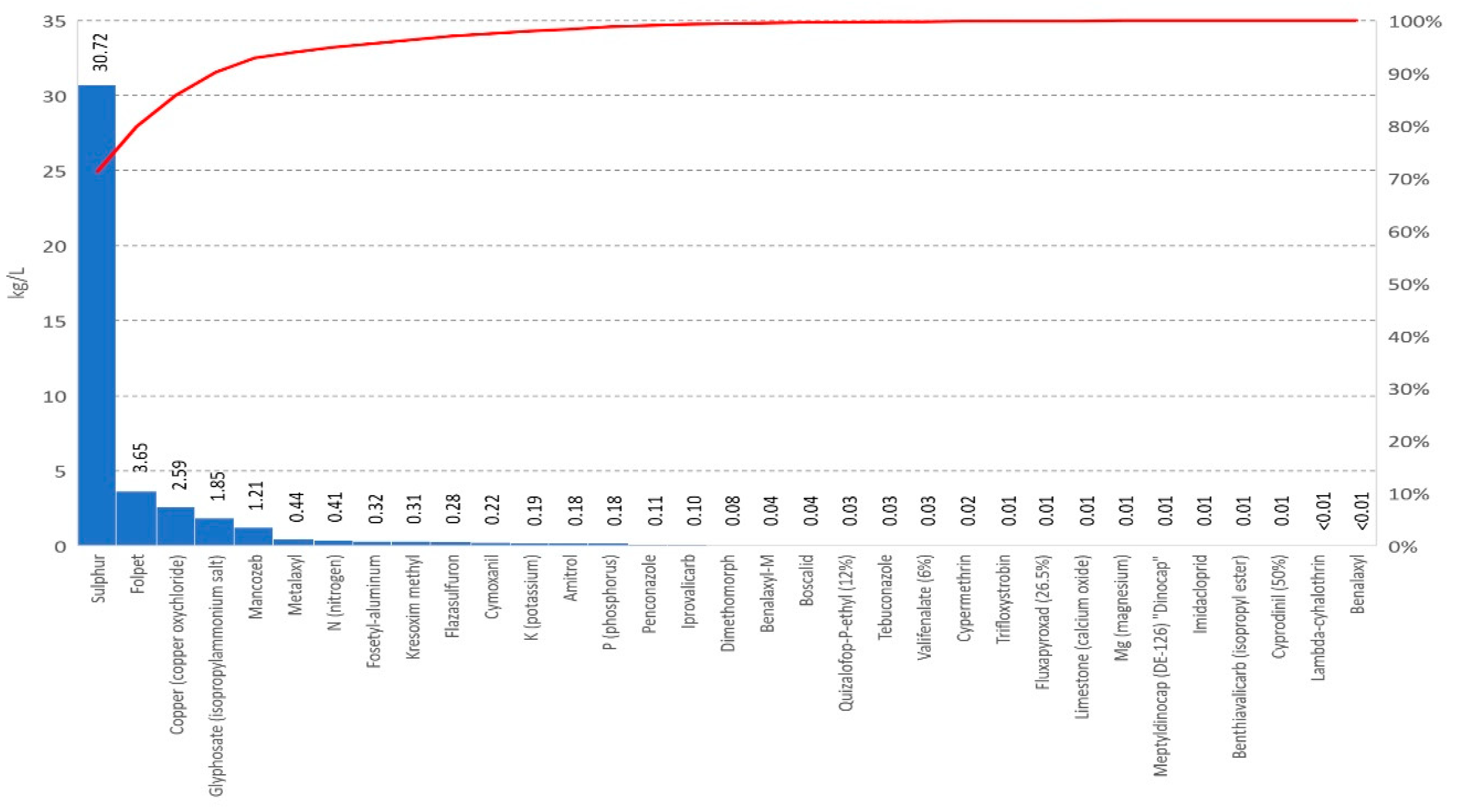
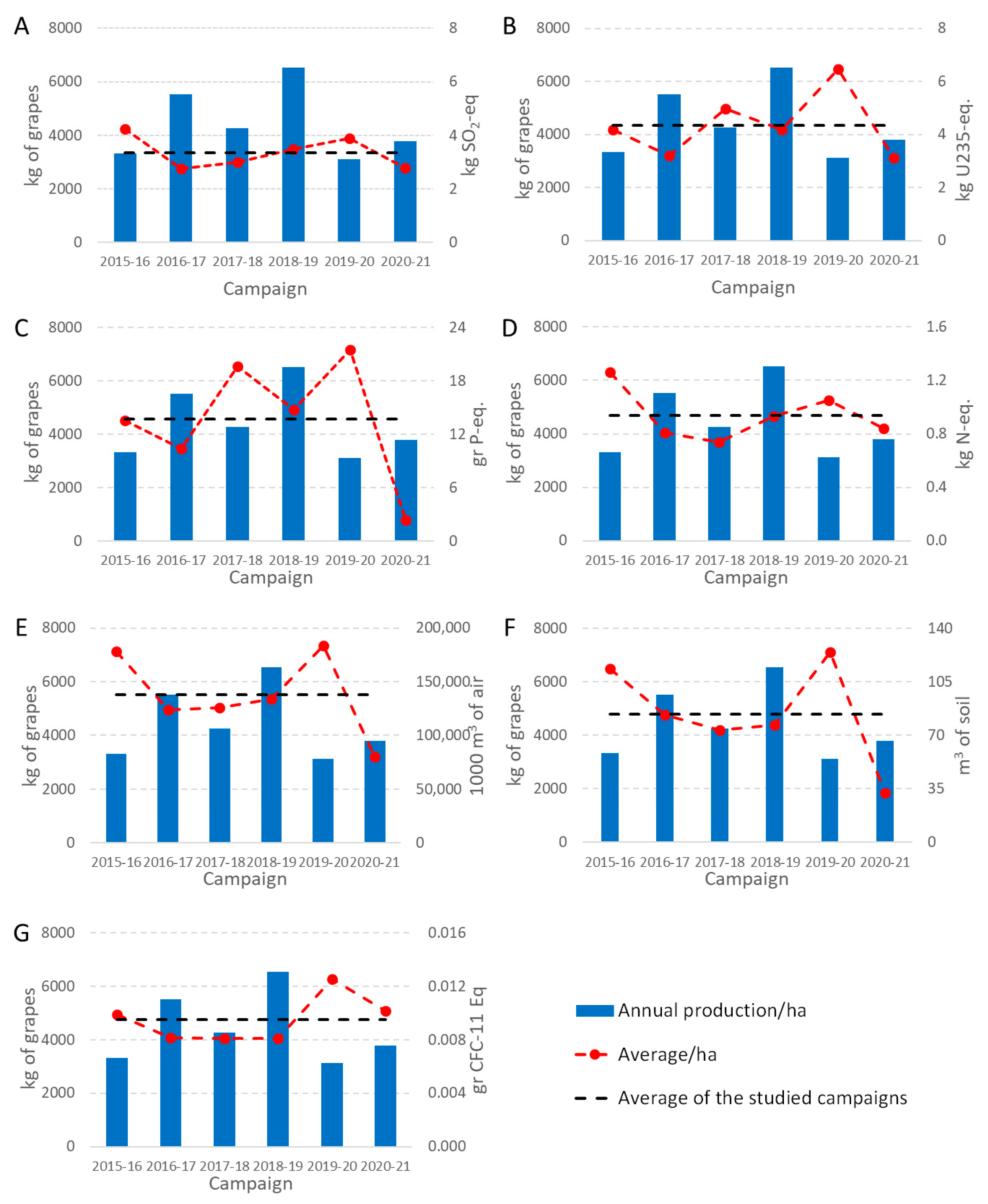
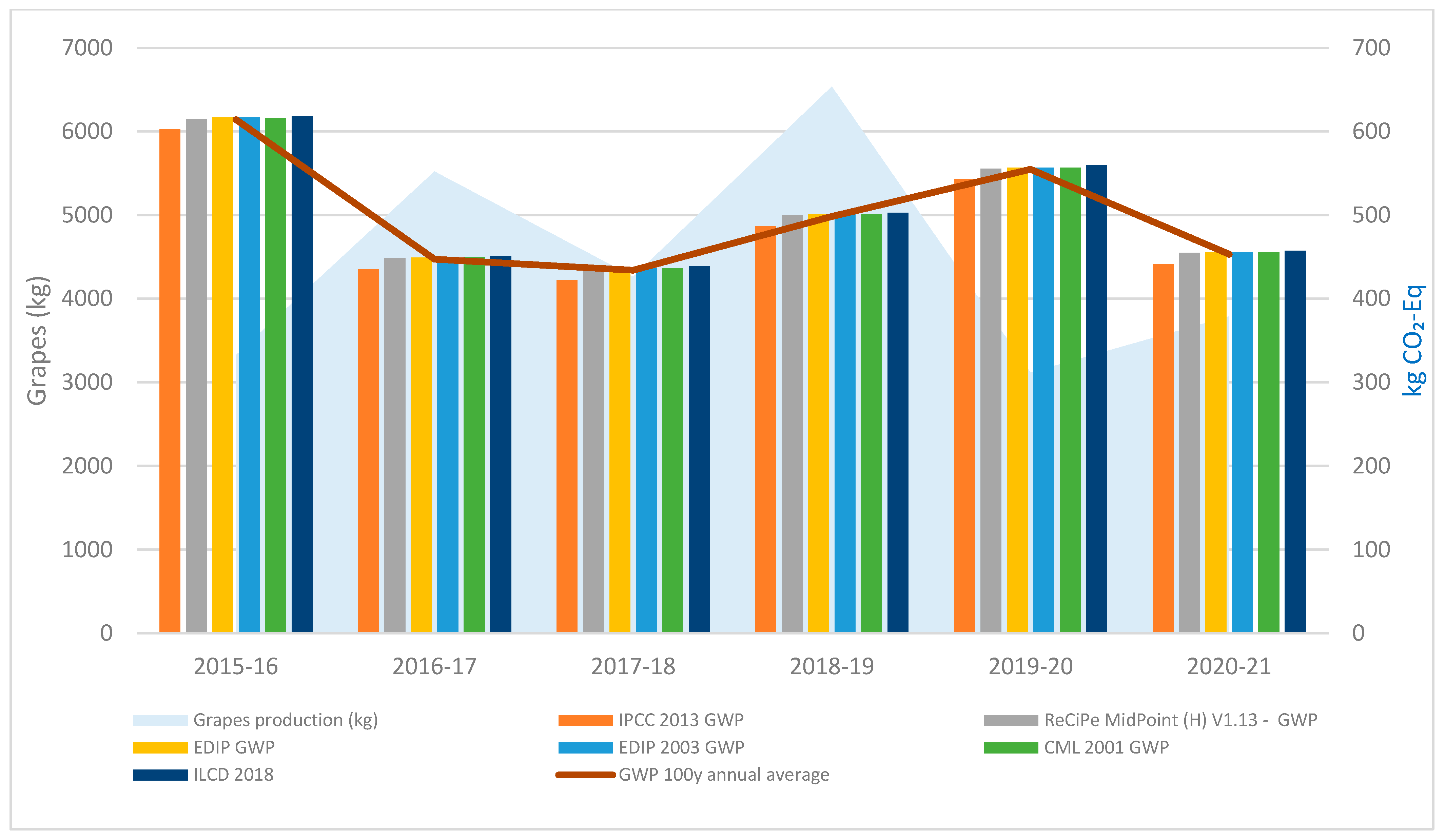
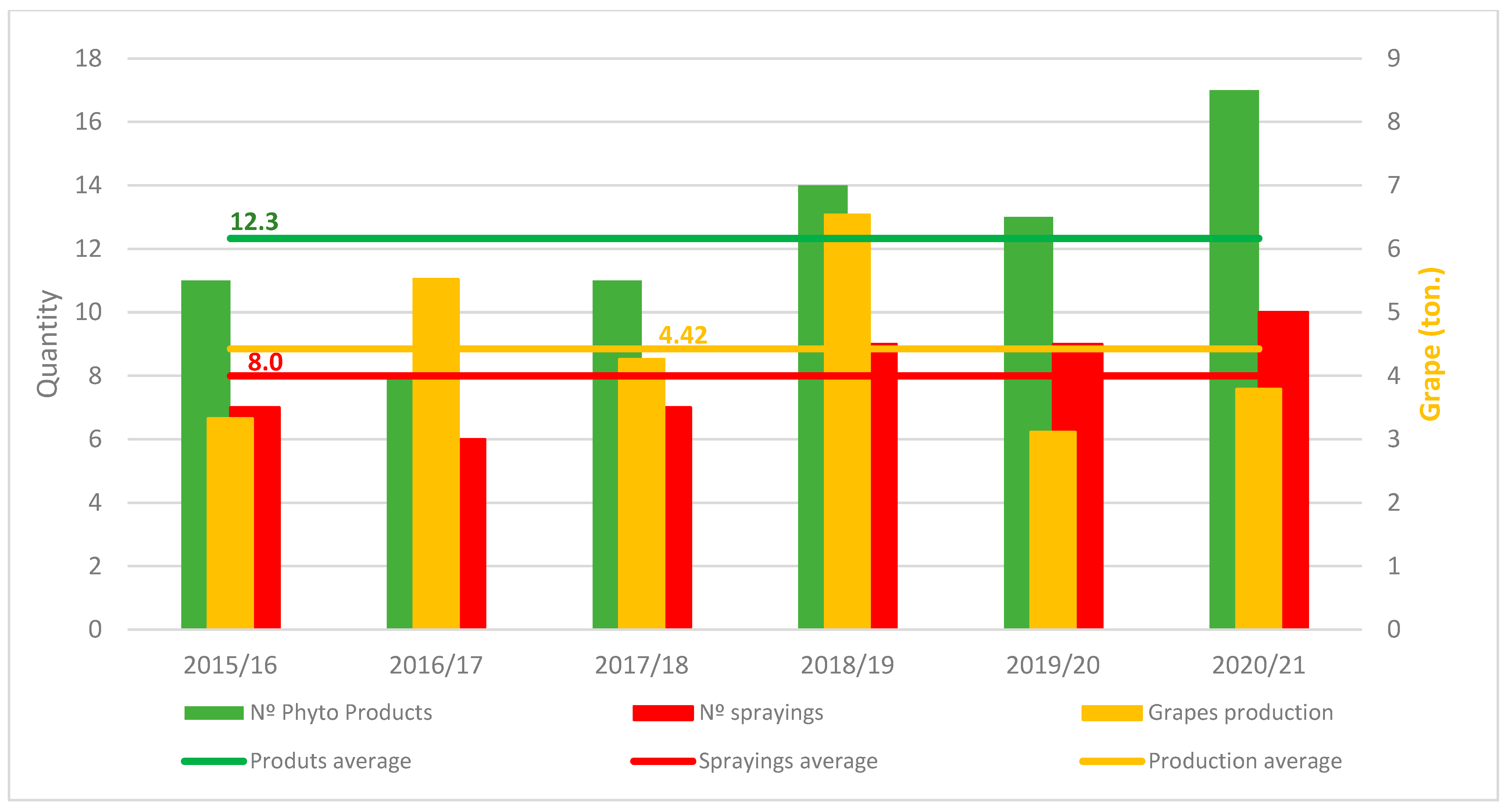
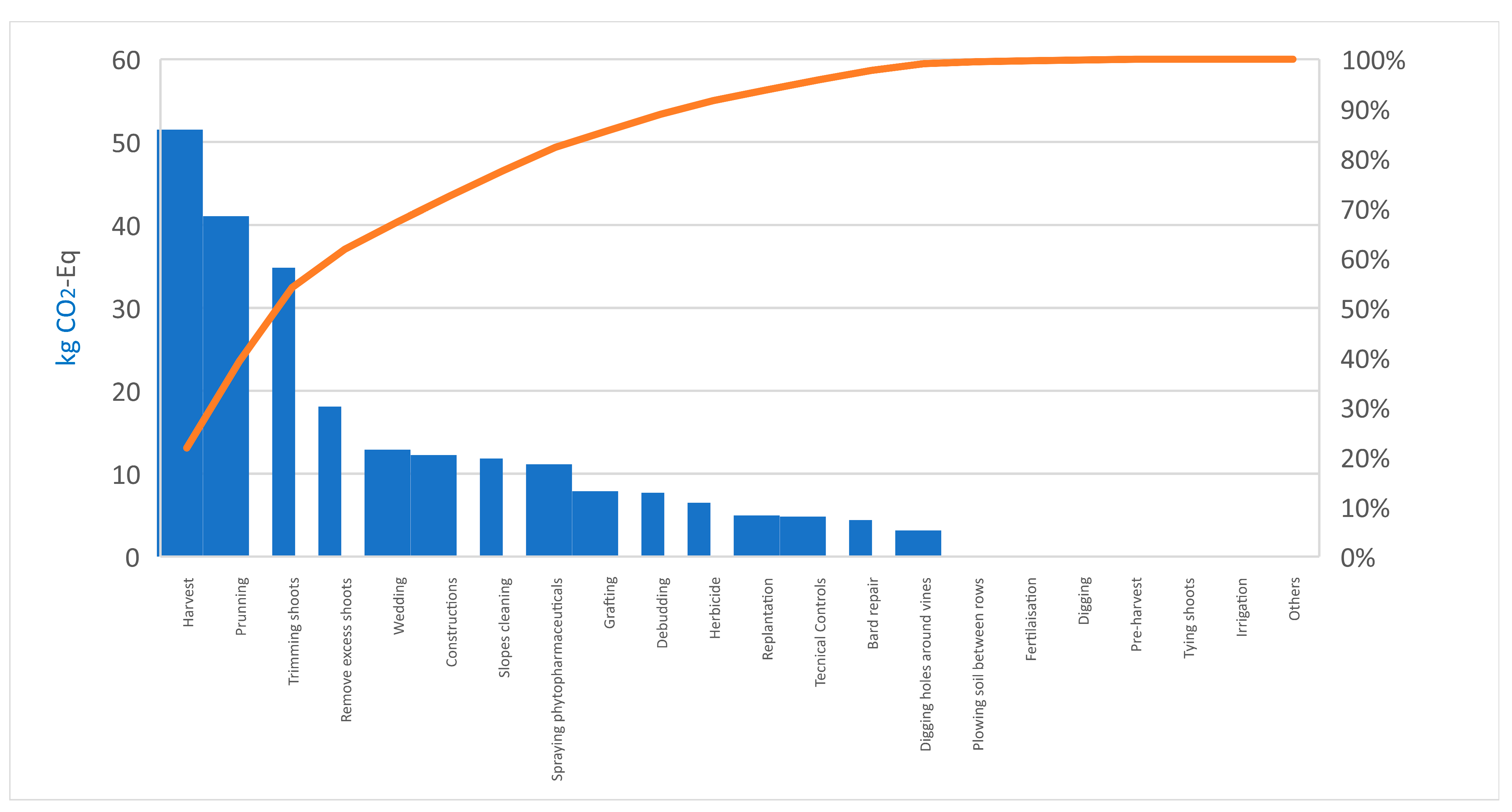
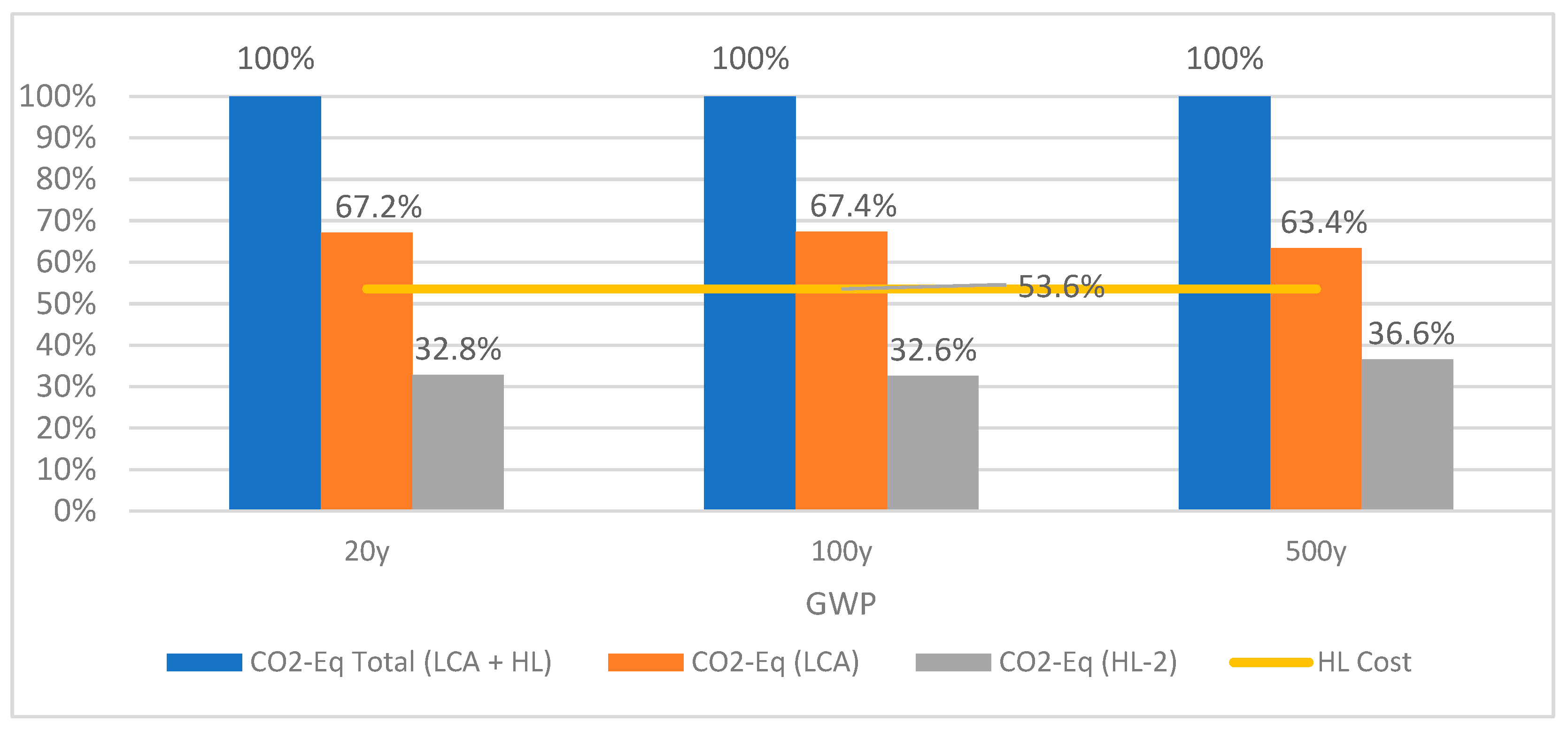
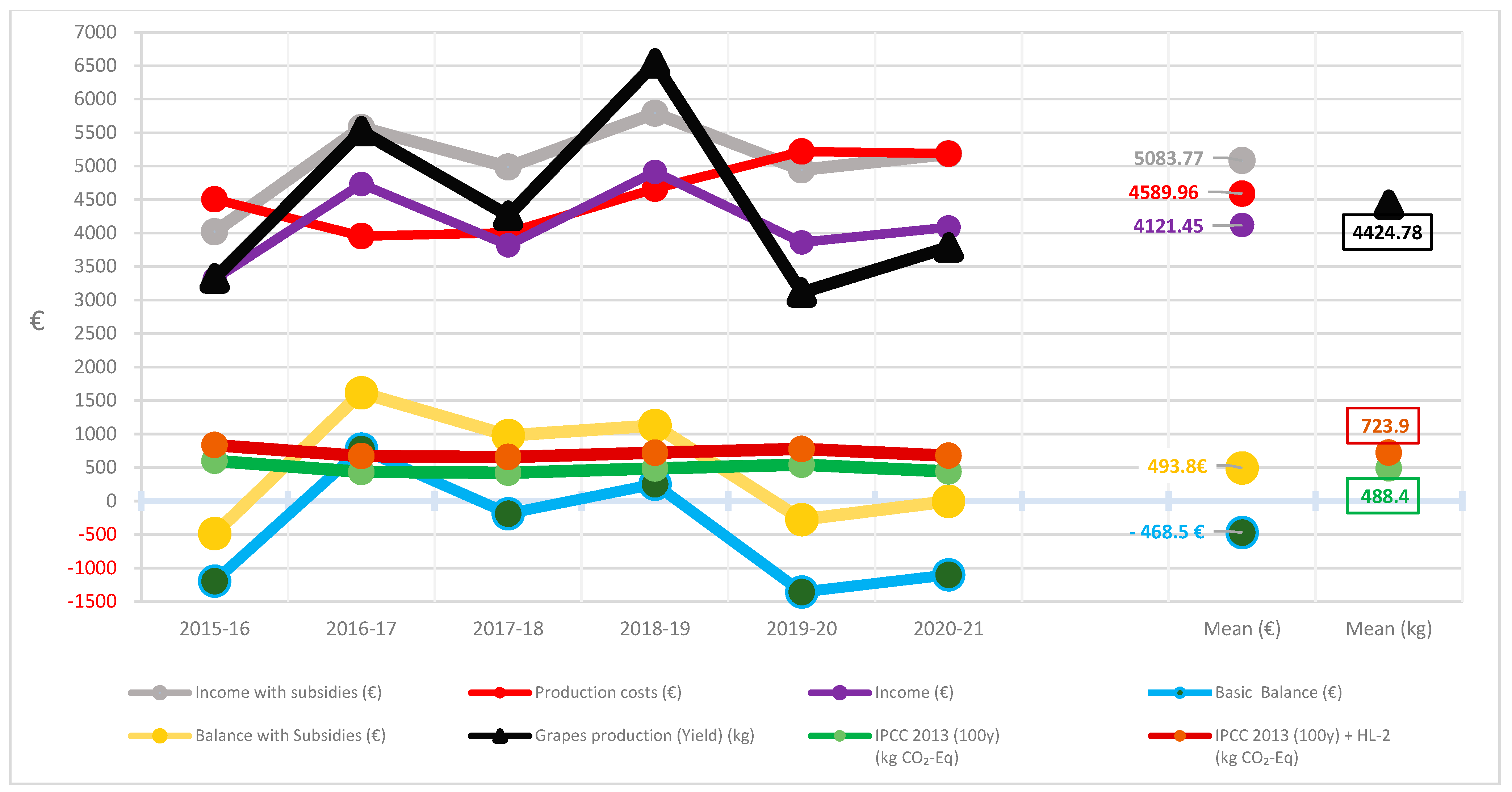
| Environmental Impact | Max | Min | Standard Deviation | |||||||
|---|---|---|---|---|---|---|---|---|---|---|
| Methods | ||||||||||
| Indicators | Unit | EDIP | EDIP 2003 | ReCiPe MidPoint (H) v1.13 | CML 2001 | ILCD 2.0—2018 Midpoint | IPCC 2013 | |||
| Eutrophication Marine | kg N-Eq | - | - | 1.742 × 10−1 | - | 1.703 × 100 | - | 1.742 × 10−1 | 1.703 × 100 | 7.652 × 101 |
| Eutrophication Freshwater | kg P-Eq | - | - | 1.371 × 10−2 | - | 1.368 × 10−2 | - | 1.371 × 10−2 | 1.368 × 10−2 | 1.535 × 10−5 |
| Acidification | kg SO2-Eq | 3.071 × 10−1 | - | 2.524 × 10−1 | 3.071 × 10−1 | - | - | 3.071 × 10−1 | 2.524 × 10−1 | 2.577 × 10−2 |
| Ionizing Radiation | kg U235-E | - | - | 4.358 × 10−1 | 4.354 × 10−1 | - | - | 4.358 × 10−1 | 4.354 × 10−1 | 2.023 × 10−4 |
| Ozone Layer Depletion | kg CFC-11-Eq | 8.724 × 10−3 | 9.207 × 10−3 | 1.003 × 10−2 | 9.207 × 10−3 | 9.896 × 10−3 | - | 1.003 × 10−2 | 8.724 × 10−3 | 4.835 × 10−4 |
| Human Toxicity (via Air) | m3 Air | 1.379 × 105 | 1.375 × 105 | - | - | - | - | 1.379 × 105 | 1.375 × 105 | 2.169 × 102 |
| Human Toxicity (via Soil) | m3 Soil | 8.398 × 10−2 | 8.398 × 10−2 | - | - | - | - | 8.398 × 10−2 | 8.398 × 10−2 | 0.000 × 100 |
| GWP 20y | CO2-Eq | 4.988 × 10−1 | 4.237 × 10−1 | - | 5.063 × 10−1 | - | 5.008 × 10−1 | 5.063 × 10−1 | 4.237 × 10−1 | 3.399 × 10−2 |
| GWP 100y | CO2-Eq | 5.024 × 10−1 | 4.265 × 10−1 | 5.015 × 10−1 | 5.025 × 10−1 | 5.046 × 10−1 | 4.884 × 10−1 | 5.046 × 10−1 | 4.265 × 10−1 | 2.786 × 10−2 |
| GWP 500y | CO2-Eq | 4.299 × 10−1 | 3.662 × 10−1 | - | 4.273 × 10−1 | - | - | 4.299 × 101 | 3.662 × 10−1 | 2.945 × 10−2 |
| GWP 20y | GWP 100y | GWP 500y | ||||
|---|---|---|---|---|---|---|
| Hectare | Kg | Hectare | Kg | Hectare | Kg | |
| LCA average | 482.38 | 0.109 | 487.63 | 0.110 | 407.80 | 0.092 |
| HL-2 | 235.51 | 0.053 | 235.51 | 0.053 | 235.51 | 0.053 |
| Total | 717.89 | 0.162 | 723.14 | 0.163 | 643.31 | 0.145 |
Disclaimer/Publisher’s Note: The statements, opinions and data contained in all publications are solely those of the individual author(s) and contributor(s) and not of MDPI and/or the editor(s). MDPI and/or the editor(s) disclaim responsibility for any injury to people or property resulting from any ideas, methods, instructions or products referred to in the content. |
© 2024 by the authors. Licensee MDPI, Basel, Switzerland. This article is an open access article distributed under the terms and conditions of the Creative Commons Attribution (CC BY) license (https://creativecommons.org/licenses/by/4.0/).
Share and Cite
Martins, J.A.; Marta-Costa, A.; Lucas, M.R.; Santos, M. Sustainability in Mountain Viticulture: Insights from a Case Study in the Portuguese Douro Region. Sustainability 2024, 16, 2050. https://doi.org/10.3390/su16052050
Martins JA, Marta-Costa A, Lucas MR, Santos M. Sustainability in Mountain Viticulture: Insights from a Case Study in the Portuguese Douro Region. Sustainability. 2024; 16(5):2050. https://doi.org/10.3390/su16052050
Chicago/Turabian StyleMartins, José António, Ana Marta-Costa, Maria Raquel Lucas, and Mário Santos. 2024. "Sustainability in Mountain Viticulture: Insights from a Case Study in the Portuguese Douro Region" Sustainability 16, no. 5: 2050. https://doi.org/10.3390/su16052050
APA StyleMartins, J. A., Marta-Costa, A., Lucas, M. R., & Santos, M. (2024). Sustainability in Mountain Viticulture: Insights from a Case Study in the Portuguese Douro Region. Sustainability, 16(5), 2050. https://doi.org/10.3390/su16052050







